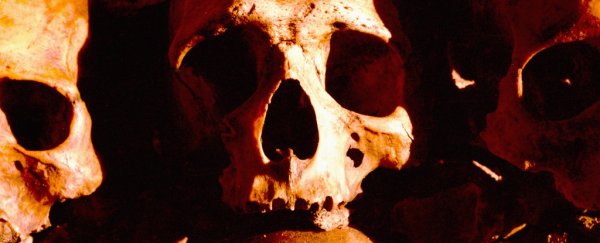Scientists think that a series of famous mass burial sites in the Pacific and northern Scotland are the final resting places for the prehistoric victims of catastrophic tsunamis.
While archaeologists have uncovered numerous mass burial sites all around the world, figuring out the story behind these mass graves can be quite difficult to determine, especially once things like disease and warfare have been ruled out.
Scientists know that the time before written history was littered with deadly natural disasters, but strangely enough, we know of very few mass burial sites that are linked to climatic and tectonic-related hazards like typhoons, earthquakes, and tsunamis.
Now, a new study on coastal burial sites has provided a window into the long-forgotten history of humans and tsunamis.
"Tsunamis have never been considered as explanations for burial sites before – which is why no prehistoric coastal mass graves have ever been identified in the archaeological record as tsunami-related," says co-author James Goff, an expert in natural hazards at UNSW's PANGEA Research Centre.
"Proving that a site is related to a past tsunami could lead to a fundamental rewrite of how we interpret coastal human settlement in prehistory, and change what we thought we knew about the culture and people living in the region at the time. It could also have dramatic implications for how archaeologists analyse a site."
The new research was focused on coastal burial sites in the South Pacific's Vanuatu and Solomon Islands, and northern Scotland's Orkney and Shetland - sites that had previously been thought to be populated by victims of warfare and disease.
These regions, however, are all known to experience tsunamis, and the ages of the mass burial sites – ranging from 500 years old to 5,000 years old – match those of the geological record for past tsunami events. The connection was too coincidental to not explore further.
"Looking at the evidence from the burial sites considering the potential of tsunamis, we were able to make a strong case for many of these sites being related to major tsunamis, as opposed to more standard explanations like warfare or an epidemic," says Goff.
More recent tsunamis in Japan and Indonesia have provided the researchers with a model for how humans tend to bury their dead after natural disasters. While each tsunami event will shake out a little differently, there are significant overlaps between mass burials in response to devastating tsunamis.
Unlike other natural disasters that cause ocean flooding, like cyclones, the huge intervals between tsunami events – around 250 to 500 years long – are far longer than any human's living experience. This means that people don't often take tsunamis into account when prioritising choices for day-to-day living and urban planning.
And, because tsunamis are notoriously difficult to predict, their destruction often arrives with little to no warning.
As a result, the death toll is often extremely high and burials must occur quickly, near the coast, and with little to no thought given to cultural traditions of burial. Even more telling, sometimes fish and animals killed in the tsunami are buried alongside human remains.
"For example, at the site in the Solomon Islands, the method of burial and the age of the people buried is consistent with what we'd expect after a tsunami – people were buried in atypical positions, and they're uncharacteristically young," says Goff.
While the causes of death at the mass burial sites may vary, the authors explain that those linked to tsunamis usually "include asphyxiation (as sediment carried in the tsunami is pushed into the lungs by the force of water), followed by drowning, impact injuries and wound infections".
Obviously, not every mass burial site along the coast is tsunami-related. The research is merely filling a gap in the historical record which has too often been overlooked due to lack of evidence.
"Our archaeological research in conjunction with geological evidence recognises that exactly what has happened in modern events must have happened in the past. This line of analysis will hopefully start being at the forefront of researchers' minds when excavating a coastal mass burial," says Goff.
The lead author of the report, Genevieve Cain from the University of Oxford, says now that she has found geological and archaeological evidence for tsunami-related deaths, she is focused on finding evidence at the skeletal level.
"There is a fairly simple way forward here. When people die in a tsunami, they inhale saltwater that contains small marine micro-organisms called diatoms, which means they suffocate and then drown," she explains.
"These diatoms travel through the blood stream and are deposited and preserved within the bone marrow of larger bones. If we can find marine diatoms, this may indicate that the body is a tsunami victim."
The study has been published in the Journal of Archaeological Method and Theory.
